SinoChallenger
BANNED

- Joined
- Nov 9, 2011
- Messages
- 3,523
- Reaction score
- 0
How China Will Fight Future Border Wars
Should a limited but high-intensity border conflict break out between China and India over the next five years, how exactly will the battles be fought? And where? The most likely answers to these two questions came from none other than Beijings Peoples Daily Online, which on November 15 last year, while commenting on the Indian Armys China-centric future force modernisation-cum-expansion plans due for implementation in the 12th Defence Plan, stated: In an era when precision-guided weapons are developing rapidly, everyone with common sense knows that concentrated troops could be eliminated easily. Translated for the layman, it means that A) the Peoples Liberation Army (PLA) will realise its tactical objectives on the ground by resorting to massed fire-assaults delivered by a numerically superior deployed force comprising tactical non-line-of-sight battlefield support missiles (NLOS-BSM) and long-range multi-barrel rocket launchers (MBRL) capable of firing rockets equipped with sensor-fuzed munitions (SGM), and B) such rocket artillery-based weapons would be employed in tactical areas that are ideally suited for deployment of such weapons, i.e. the flat, locational deserts around eastern Ladakh and the foothills opposite Uttarakhand State. And it is exactly in these areas that, for the second year in a row, the PLA Army and the PLA Air Force (PLAAF) last year conducted Brigade-level live-fire exercises on the foot of the snowcapped mountains on the Qinghai-Tibet Plateau at an altitude of more than 5,000 metres. Though the exercises, dubbed as Integrated Joint Operations (IJO), were conducted under the command of the Tibet Military District, which comes under the Chengdu Military Region (MR), a few select field artillery and armoured formations belonging to the Lanzhou MR also took part in the combined arms exercises, which got underway last July and lasted till last October.


Weapon systems deployed by the PLA for the very first time in the exercises included the NORINCO-built 300mm PHL-05 MBRLs, Type 90 122mm MBRLs, PLZ-07 122mm tracked self-propelled howitzers, Type 95 PGZ-95 self-propelled air-defence artillery systems, Type 96G main battle tanks, Type 86G tracked infantry combat vehicles, Type 704 weapons locating radars, FN-6 MANPADS, and Mi-17V-5 assault helicopters capable of transporting special operations detachments. PLAAF elements deployed this time at Shigatse air base between last August and November included six Su-27SKs and Su-30MK2s and three J-10 combat aircraft. Shigatse is now being upgraded into Tibets first all-weather air base capable of sustaining high-intensity offensive air sorties, and is now protected by the HQ-12/KS-1A MR-SAM air defence system and a combination of FN-6 MANPADS and SmartHunter low-probability-og-intercept radars. And in another first for the PLAAF, a detachment of four J-10 MRCAs from the Chengdu Military Region began a two week-long deployment at Shigatse starting January 21, during which tactical airspace dominance exercises were conducted in coordination with the PLAAFs ground-based airspace surveillance radar stations deployed within the Tibet Military District.
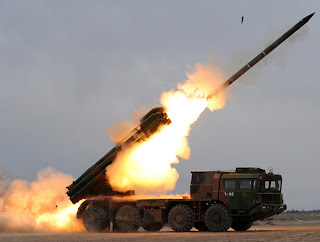

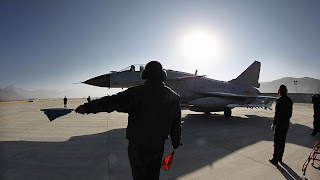
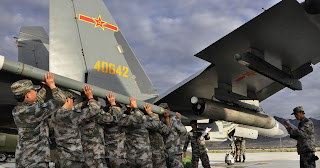
Also deployed for exercises were the PLA Armys NLOS-BSMs, which have been stockpiled in both Xinjiang and Aksai Chin. To date, 13 tunnels dug into the mountains have been built at Xiadulla, 98km from the Karakoram mountain pass between Ladakh and the Xinjiang Uyghur Autonomous Region, while another similar NLOS-BSM storage facility is located at Qizil Jilga, 40km off the LAC in eastern Ladakh near the Western Tibet highway. It is believed that the NLOS-BSMs located in these areas will be employed against the Indian Air Forces existing air bases and Advanced Landing Grounds in both Jammu & Kashmir and Uttarakhand.
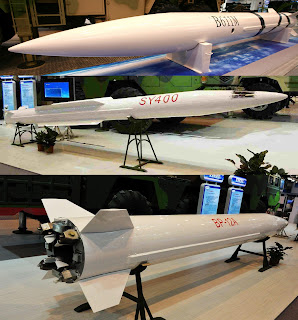
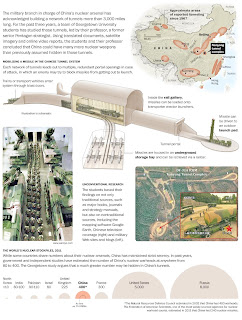
NLOS-BSMs for the PLA Army have been developed two state-owned entities: China National Precision Machinery Import & Export Corp (CPMIEC), and Aerospace Long-March International Trade Co Ltd (ALIT). The latters latest product is the P-20, which has been exported to Pakistan, where it known as the Hatf-9/Nasr. Capable of striking targets between 70km and 270km, the all-weather capable M-20, with a Mach 3 cruise speed, comes armed with both a 200kg unitary high-explosive (HE) blast-fragmentation warhead for engaging high-value and time-sensitive targets, as well as a sub-kiloton yield tactical nuclear warhead. Two P-20s housed inside cannisters are mounted on an 8 x 8 transporter/erector/launcher (TEL). For navigation purposes, use is made of a ring laser gyro-based inertial navigation system (RLG-INS) coupled to a GPS receiver (for receiving high-accuracy navigational updates in secure PY-code from Chinas Beidou constellation of GPS satellites), and an infra-red sensor for terminal homing that gives the missile a CEP of less than 10 metres. CPMIECs 2-tonne B-611M missile is designed to attack supply lines, warehouses, ballistic/cruise missile launch sites, SAM batteries, command-and-control centres, air bases, road/railway transportation hubs, and area targets in urban surroundings. Armed with a 480kg HE warhead, the B-611M has 280km range. Up to two cannister-mounted B-611Ms can be carried by a wheeled TEL. Another NLOS-BSM from CPMIEC is the P-12, which made its public debut in November 2006. Up to two P-12s are carried in an enclosed compartment mounted on a 6 x 6 TEL. The P-12 has a range of 150km, and it comes armed with either a 300kg HE blast fragmentation warhead, or a cluster warhead containing 19 anti-armour sub-munitions. Both the B-611M and P-12 have a CEP of about 2 metres when using a RLG-INS coupled to a GPS receiver, plus an optronic sensor for terminal homing. CPMIECs latest NLOS-BSM offering is the vertically-launched joint attack rocket & missile (JARM) system, which can fire both the 280km-range BP-12A and the 200km-range SY-400 from a common launch platform. The JARM, which made its public debut in November 2010, makes use of combined GPS-RLG-INS navigation systems to achieve a CEP of 3 metres A typical JARM Battery comprises ten 8 x 8 TELs housing either 80 SY-400s or 20 BP-12As, or a combination of both.
These NLOS-BSMs and MBRL rockets armed with SFMs are all equipped with micro-electro-mechanical systems (MEMS) developed by Chinas Kotel Micro Technique Co Ltd. The set of components manufactured include up to three SAK01-03 acceleration switches that interactively operate with one another and provide pressure and acceleration data that are then fed into the flight-guidance system, FKZD-01 vibration sensor, and the INS-M100 MEMS, operating at an RS422 bit-rate, measuring only 120mm x 120mm x 120mm, and using GPS data for its targetting system. This same company also supplies optronic terminal guidance sensors for the Fei Teng (FT)-1 and FT-3 precision-guided bombs developed by the China Academy of Launch Vehicle Technology (CALT), and for the Leishi (LS)-6 extended-range glide bomb and the (Leiting) LT-2 laser-guided bomb developed by the Luoyang Optical-Electronic Technology Development Centre (LOEC). In addition to such components, Chinas NLOS-BSMs also reportedly make use of MEMS-based guidance equipment supplied by Norwegian electronics manufacturer, Sensonor. One such piece of hardware, the STIM202 Butterfly gyro, is a 55-gram miniature module that replaces previous-generation fibre-optic, ring-laser and mechanical gyros. The STIM202 is based on single-crystal silicon technology, can be configured in one-, two- or three-axis capability, and offers 24-bit resolution plus an RS422 bit-rate. The STIM202 is so small and light that the designers of a missile system can use two of the modules to provide the weapons on-board guidance module with back-up redundancy, which was never a possibility with previous-generation guidance components.
In addition to deploying NLOS-BSMs and MBRLs in greater numbers, the PLA Army is also increasing the deployed strength of its main battle tanks (MBT) and infantry combat vehicles (ICV) that are attached to select formations within the PLAs Chengdu and Lanzhou Military Regions (MR). In early March last year, the 1st Tank Battalion of the 348th Mechanised Infantry Regiment of the 37th Motor Infantry Division of the 13th Group Army in Chengdu commissioned the Type 96G MBT into its ORBAT, marking it the third Type 96G MBT-equipped unit in the western mountainous region opposite northeastern India. The first two units are the 149th Mechanised Infantry Division and the 52nd Mountain Brigade, all presently based in southeastern Tibet. Earlier, on March 17, 2010 the PLA had for the first time in its history deployed MBTs in the Tibet (Xizang) Military District, these too being Type 96G MBTs.
TRISHUL: How China Will Fight Future Border Wars
Some relevant comments
The above article is a very accurate description of China's war preparations. Currently, india estimates that it can develop a reasonably reliable nuclear delivery vehicle in 4 to 6 years to threaten China, and will fight a limited war against China in the border area immediately thereafter to cement its hold on Southern Tibet.
Should a limited but high-intensity border conflict break out between China and India over the next five years, how exactly will the battles be fought? And where? The most likely answers to these two questions came from none other than Beijings Peoples Daily Online, which on November 15 last year, while commenting on the Indian Armys China-centric future force modernisation-cum-expansion plans due for implementation in the 12th Defence Plan, stated: In an era when precision-guided weapons are developing rapidly, everyone with common sense knows that concentrated troops could be eliminated easily. Translated for the layman, it means that A) the Peoples Liberation Army (PLA) will realise its tactical objectives on the ground by resorting to massed fire-assaults delivered by a numerically superior deployed force comprising tactical non-line-of-sight battlefield support missiles (NLOS-BSM) and long-range multi-barrel rocket launchers (MBRL) capable of firing rockets equipped with sensor-fuzed munitions (SGM), and B) such rocket artillery-based weapons would be employed in tactical areas that are ideally suited for deployment of such weapons, i.e. the flat, locational deserts around eastern Ladakh and the foothills opposite Uttarakhand State. And it is exactly in these areas that, for the second year in a row, the PLA Army and the PLA Air Force (PLAAF) last year conducted Brigade-level live-fire exercises on the foot of the snowcapped mountains on the Qinghai-Tibet Plateau at an altitude of more than 5,000 metres. Though the exercises, dubbed as Integrated Joint Operations (IJO), were conducted under the command of the Tibet Military District, which comes under the Chengdu Military Region (MR), a few select field artillery and armoured formations belonging to the Lanzhou MR also took part in the combined arms exercises, which got underway last July and lasted till last October.


Weapon systems deployed by the PLA for the very first time in the exercises included the NORINCO-built 300mm PHL-05 MBRLs, Type 90 122mm MBRLs, PLZ-07 122mm tracked self-propelled howitzers, Type 95 PGZ-95 self-propelled air-defence artillery systems, Type 96G main battle tanks, Type 86G tracked infantry combat vehicles, Type 704 weapons locating radars, FN-6 MANPADS, and Mi-17V-5 assault helicopters capable of transporting special operations detachments. PLAAF elements deployed this time at Shigatse air base between last August and November included six Su-27SKs and Su-30MK2s and three J-10 combat aircraft. Shigatse is now being upgraded into Tibets first all-weather air base capable of sustaining high-intensity offensive air sorties, and is now protected by the HQ-12/KS-1A MR-SAM air defence system and a combination of FN-6 MANPADS and SmartHunter low-probability-og-intercept radars. And in another first for the PLAAF, a detachment of four J-10 MRCAs from the Chengdu Military Region began a two week-long deployment at Shigatse starting January 21, during which tactical airspace dominance exercises were conducted in coordination with the PLAAFs ground-based airspace surveillance radar stations deployed within the Tibet Military District.




Also deployed for exercises were the PLA Armys NLOS-BSMs, which have been stockpiled in both Xinjiang and Aksai Chin. To date, 13 tunnels dug into the mountains have been built at Xiadulla, 98km from the Karakoram mountain pass between Ladakh and the Xinjiang Uyghur Autonomous Region, while another similar NLOS-BSM storage facility is located at Qizil Jilga, 40km off the LAC in eastern Ladakh near the Western Tibet highway. It is believed that the NLOS-BSMs located in these areas will be employed against the Indian Air Forces existing air bases and Advanced Landing Grounds in both Jammu & Kashmir and Uttarakhand.


NLOS-BSMs for the PLA Army have been developed two state-owned entities: China National Precision Machinery Import & Export Corp (CPMIEC), and Aerospace Long-March International Trade Co Ltd (ALIT). The latters latest product is the P-20, which has been exported to Pakistan, where it known as the Hatf-9/Nasr. Capable of striking targets between 70km and 270km, the all-weather capable M-20, with a Mach 3 cruise speed, comes armed with both a 200kg unitary high-explosive (HE) blast-fragmentation warhead for engaging high-value and time-sensitive targets, as well as a sub-kiloton yield tactical nuclear warhead. Two P-20s housed inside cannisters are mounted on an 8 x 8 transporter/erector/launcher (TEL). For navigation purposes, use is made of a ring laser gyro-based inertial navigation system (RLG-INS) coupled to a GPS receiver (for receiving high-accuracy navigational updates in secure PY-code from Chinas Beidou constellation of GPS satellites), and an infra-red sensor for terminal homing that gives the missile a CEP of less than 10 metres. CPMIECs 2-tonne B-611M missile is designed to attack supply lines, warehouses, ballistic/cruise missile launch sites, SAM batteries, command-and-control centres, air bases, road/railway transportation hubs, and area targets in urban surroundings. Armed with a 480kg HE warhead, the B-611M has 280km range. Up to two cannister-mounted B-611Ms can be carried by a wheeled TEL. Another NLOS-BSM from CPMIEC is the P-12, which made its public debut in November 2006. Up to two P-12s are carried in an enclosed compartment mounted on a 6 x 6 TEL. The P-12 has a range of 150km, and it comes armed with either a 300kg HE blast fragmentation warhead, or a cluster warhead containing 19 anti-armour sub-munitions. Both the B-611M and P-12 have a CEP of about 2 metres when using a RLG-INS coupled to a GPS receiver, plus an optronic sensor for terminal homing. CPMIECs latest NLOS-BSM offering is the vertically-launched joint attack rocket & missile (JARM) system, which can fire both the 280km-range BP-12A and the 200km-range SY-400 from a common launch platform. The JARM, which made its public debut in November 2010, makes use of combined GPS-RLG-INS navigation systems to achieve a CEP of 3 metres A typical JARM Battery comprises ten 8 x 8 TELs housing either 80 SY-400s or 20 BP-12As, or a combination of both.
These NLOS-BSMs and MBRL rockets armed with SFMs are all equipped with micro-electro-mechanical systems (MEMS) developed by Chinas Kotel Micro Technique Co Ltd. The set of components manufactured include up to three SAK01-03 acceleration switches that interactively operate with one another and provide pressure and acceleration data that are then fed into the flight-guidance system, FKZD-01 vibration sensor, and the INS-M100 MEMS, operating at an RS422 bit-rate, measuring only 120mm x 120mm x 120mm, and using GPS data for its targetting system. This same company also supplies optronic terminal guidance sensors for the Fei Teng (FT)-1 and FT-3 precision-guided bombs developed by the China Academy of Launch Vehicle Technology (CALT), and for the Leishi (LS)-6 extended-range glide bomb and the (Leiting) LT-2 laser-guided bomb developed by the Luoyang Optical-Electronic Technology Development Centre (LOEC). In addition to such components, Chinas NLOS-BSMs also reportedly make use of MEMS-based guidance equipment supplied by Norwegian electronics manufacturer, Sensonor. One such piece of hardware, the STIM202 Butterfly gyro, is a 55-gram miniature module that replaces previous-generation fibre-optic, ring-laser and mechanical gyros. The STIM202 is based on single-crystal silicon technology, can be configured in one-, two- or three-axis capability, and offers 24-bit resolution plus an RS422 bit-rate. The STIM202 is so small and light that the designers of a missile system can use two of the modules to provide the weapons on-board guidance module with back-up redundancy, which was never a possibility with previous-generation guidance components.
In addition to deploying NLOS-BSMs and MBRLs in greater numbers, the PLA Army is also increasing the deployed strength of its main battle tanks (MBT) and infantry combat vehicles (ICV) that are attached to select formations within the PLAs Chengdu and Lanzhou Military Regions (MR). In early March last year, the 1st Tank Battalion of the 348th Mechanised Infantry Regiment of the 37th Motor Infantry Division of the 13th Group Army in Chengdu commissioned the Type 96G MBT into its ORBAT, marking it the third Type 96G MBT-equipped unit in the western mountainous region opposite northeastern India. The first two units are the 149th Mechanised Infantry Division and the 52nd Mountain Brigade, all presently based in southeastern Tibet. Earlier, on March 17, 2010 the PLA had for the first time in its history deployed MBTs in the Tibet (Xizang) Military District, these too being Type 96G MBTs.
TRISHUL: How China Will Fight Future Border Wars
Some relevant comments
TRISHUL: Desi Yellow Journalism At Its Very BestThere is already an on-going proxy war between China and India, which began in the mid-1970s when both China and Pakistan began coordinating with one another for subverting India militarily. When it comes to full-scale hostilities for the future, it is still four to six years away and will involve only a high-intensity limited border war in which the nuclear escalatory ladder will not be completely climbed, i.e. at the most threats of using tactical nuclear weapons will be made by China. Therefore, to deter China, what India first and foremost needs are not SLBMs, but tactical nuclear warheads capable of being launched by Nirbhay ALCMs and land-launched Shaurya TBMs.
TRISHUL: How China Will Fight Future Border Warsso after reading this article what I understand is, the PLA would start the hostilities at a time and place of its own choosing by mobilising their RRFs supported with its own integral air assets and artillery as well as the PLAAF to quickly try and break INDIAN defences and capture tawang.while simultaneously resorting to use of NLOS-BSMs and artillery both tube and rocket as well as cruise missiles to neutralise IAF bases and forward ALGs and important c&c installations as well as logistics bases and important infrastructure nodes besides using their SOFs to destroy all of the above as well as SAM sites and SSM sites.
this simultaneous action would result in INDIA not being able to use its air assets effectively, and cutting off the defending forces from the other parts of the country so as to not facilitate any reinforcements. Thereby achieving victory in a short span of time. it is quite likely that the same approach would be used capture or engage other parts of INDIA facing China and who knows the PLA might also use its presence in *** to open another front against INDIA.
what we are eagerly waiting for is 1)how the INDIAN armed forces is planning to counter them???
2)incase we are able to stop the first set of mobilised RRFs,how would we be looking to stop the other arriving RRFs???
3)how are we going to tackle the EW and IW and cyber warfare capabilities of the chinese??
4)I strogly believe that INDIA's traditional stance of a defensive defence would not help, rather we should switch to Active Defence,wherein as and when the PLA mobilisation is spotted through means of HUMINT and other intelligence inputs, we should look to deploy our NLOS-BSMs, cruise missiles and shaurya missiles to immediately bring down the infrastructure in the TAR that facilitates speedy mobilisation of troops of the PLA, simultaneously we should look at destroying the air bases present in the TAR as well as the TBM launch sites and c&c nodes and logistics bases. apart from all this we should try and launch a counter attack, sufficiently backed by TBMs,cruise missiles and artillery as well as air power, into the enemy territory to tie down PLA's resources. and should the PLA choose to open another front in *** and aksai chin INDIA should be careful and launch surgical pre-emptive strikes in these areas without attacking pakistani installations and ensuring minimum collateral damage.
This way we would be able to significantly gain a foothold vis-a-vis the chinese and pbviously for all these to happen a multi layered Air Defence is required, besides imparting sufficient air defence assets to the field formations of the army.
now a point to note is china might not like even a status-quo as it might have so many ramifications for china as far as its strategic goal is concerned, so it might choose to escalate the war by striking deep within INDIA by using its TBMs and LACMs besides using sophisticated cyber attacks to destabilise the INDIAN economy, if so, then i believe even we should look to acquire deep strike capability using steep dive cruise missiles to target PLA's mainland air bases and LACM launch sites.PLAN might resort to using their SSNs to attack a few INDIAN cities in southern INDIA, what is to be asked is if our ASW capability is good enough to stop such a thing???
its very much possible given how the chinese doctrine advocates such 'key points strike' to break the enemy early on and seize the initiative.
Firstly, theyre not fighting PLA troops within ***, but personnel of the PLAs construction corps. Theyre unarmed and are involved in only civil engineering works. Secondly, no ones seeking any base inside ***, least of all the Chinese. What the PLA wants is to set up a network of SIGINT stations in an arc around the FATA region of northwest Pakistan so that communications of Uighur separatists located there as well as in Xinjiang can be monitored. Thirdly, as of early 2011, China has stopped referring to the state of J & K as a disputed territory under Indias administrative control and now officially regards the entire state of J & K to be disputed territory, meaning the LAC ends at Uttarakhand and does not proceed up to Aksai Chin! Consequently, what this means is that in future, if a limited high-intensity border war breaks out between China & India, it will be waged in this very area, and not in northeast Indias Tawang Tract. And thats why the PLA is beefing up its military infrastructure and warfighting capabilities in both Aksai China & ***. And thats precisely why the Indian Army wants to raise an air-assault division that will be deployed during peacetime in the eastern sector (so that it always stays acclimatised for high-altitude warfare) but not for waging war in northeast India. Given the omni-role and omni-directional nature of such an air-assault division (now that the Mi-17V-5s and C-17As are being procured to ensure swift deployments), it will be easy for the Army to quickly deploy such a division to any trouble-spot all along Indias northern borders, be it in Sikkim, Uttarakhand or J & K. Bottomline: theres no serious threat to Arunachal Pradesh from the PLA since no meaningful territorial gains are possible there. On the other hand, the Aksai Chin is of great strategic importance to China and therefore will be the principal battleground, with the areas around Sikkim and Uttarakhand serving as secondary pressure-points for staging distracting feints.
TRISHUL: PLAs New Airborne AccretionsThe BrahMos-1s Block-3 rounds are the ones that have a 550km-range and they have been built so from the start.
The above article is a very accurate description of China's war preparations. Currently, india estimates that it can develop a reasonably reliable nuclear delivery vehicle in 4 to 6 years to threaten China, and will fight a limited war against China in the border area immediately thereafter to cement its hold on Southern Tibet.








 not going to happe
not going to happe n.... Lets put in this way: It is more likely US will attack Pakistan tomorrow then china doing the same to India.
n.... Lets put in this way: It is more likely US will attack Pakistan tomorrow then china doing the same to India.